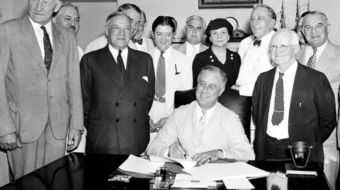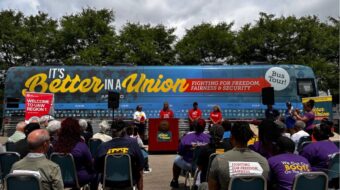Some good news came recently under the category of labor unity.
The Service Employees and the California Nurses Association have ended a yearlong jurisdictional dispute, agreeing to work together to unionize hospital workers and push for universal health coverage.
Their agreement, announced March 19, calls for coordination in contract talks and in fighting for passage of the Employee Free Choice Act, legislation that makes it easier to unionize, and for single-payer health care legislation.
The agreement between SEIU and the nurses reflects a larger, more pronounced overall trend toward unity in the labor movement, apparent even during the 2005 split-off of several unions from the AFL-CIO.
At that time, several unions affiliated with the then-63-member AFL-CIO pulled out over issues related to structure, governance, finance and programs. They formed the Change to Win federation.
During those days, numerous media outlets that had never covered labor meetings before flocked to national labor events hoping to show some political blood and gore.
The same thing may happen today.
For example, delegates claiming to represent 150,000 members of Unite Here voted March 21 in Philadelphia to secede from that union and affiliate with, though not actually join, SEIU. They set up a new organization called Workers United.
The Unite Here board, meanwhile, voted to withdraw from Change to Win, of which SEIU is the largest member, and has opened talks on rejoining the AFL-CIO.
Unite merged with Here in 2004. Reflecting on the current strife, some union leaders have noted that sometimes mergers don’t work.
However, a number of published reports focus on the splits without looking at the longer-term trend towards unity in the labor movement.
“Now is the time to bring the union movement back together,” the AFL-CIO declared in a March 4 statement authorizing discussions aimed at reuniting its 56 unions with those of Change to Win. The AFL-CIO Executive Council voted, at its March meeting in Miami, to authorize unity discussions that had already begun.
“The economic crisis facing American workers provides us with clear authorization to act for labor unity,” the Miami resolution noted.
In January, the presidents of 12 of the country’s largest unions called for reuniting the labor movement. Participating in their unity meeting were the presidents of five of the Change to Win’s seven unions and six AFL-CIO unions, and National Education Association President Dennis Van Roeckel. His 3.2-million-member union is the nation’s largest and has always remained outside any labor federation.
Leaders of several Change to Win unions have said for quite a while now that they see little advantage in maintaining a separate labor federation.
The call for reunification also came after clear signals from the Obama administration that it agreed with unions that labor’s interests would be best served in the coming period if there was a united movement.
This unity effort is “welcomed by local labor movements and stands to benefit all working people in this country,” Dennis Gannon, president of the Chicago Federation of Labor, said Jan. 8. “With a united labor movement, we will be in a better position to make real differences for working families across this great country.”
The 12 union presidents at the January meeting said: “The goal of the meeting is to create a unified labor movement that can speak and act nationally on the critical issues facing working Americans. While we represent the largest labor unions, we recognize that unity requires broad participation.”
Member unions of both federations have drawn closer together in the past few years as they have worked in common on organizing, for passage of the Employee Free Choice Act and for national health care.
And almost every union in the country, including the few that have been involved in disputes with other unions, mounted what was perhaps the biggest, most united effort ever in labor history to elect Barack Obama in 2008.
Labor joined with civil and immigrant rights groups, women’s organizations, religious leaders and many others in that historic election. The success of that effort has increased momentum for unity of action on a wide range of issues throughout the labor movement and with allies.
While the road to labor unity has obstacles, the force of necessity is more powerful.
jwojcik @ pww.org









